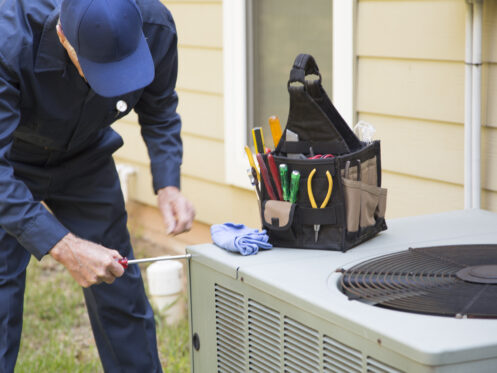You might think it will be easy to select a new air conditioner for your Dallas, OR home. However, purchasing the wrong size can lead to a lot of frustration, including inadequate cooling, increased wear and tear, and excessive energy consumption. Fortunately, we’re here to help make sure you buy an AC unit that will work adequately for your residence.
What Size Air Conditioner Do You Need?
Many people who are operating on a tight budget try to save money by purchasing a smaller AC unit than their home requires. Although this may save them some money initially, it will ultimately leave them uncomfortable and unsatisfied. The best way to determine the size your Dallas home truly needs is to consult with a professional HVAC company. We have the expertise to quickly assess your house and provide you with a recommendation for exactly what you should have.
How does an HVAC expert from our team make this determination? They do it by carefully considering the following aspects of your Dallas home:
Size of Your Residence
Your home’s square footage is where the process begins. Our professionals can take measurements in each room to accurately determine how large your house is. This is done by taking the width and length of each room and multiplying them together. Having an accurate square footage amount is one of the most critical aspects of purchasing an AC. For instance, you wouldn’t want to purchase a two-ton air conditioner to cool off a home with 2,200 square feet. Instead, your home size would require a 3.5-ton AC.
Complexity of Room Shapes
If your Dallas home happens to have complex room shapes, it will be important to take even more care when determining your total square footage. Using simple shapes such as triangles, rectangles, or squares allows you to calculate the square footage of each shape before you add them all together.
Cooling Capacity
Next, it’s necessary to calculate the cooling capacity of each room. A simple way to do this is to take your home’s square footage and multiply it by 20 BTUs. For example, if you have a 2,200-square-foot house to cool, your cooling capacity is approximately 44,000 BTU.
Necessary Adjustments
You’ll need to figure out whether your rooms are insulated sufficiently or if they suffer due to having poor insulation or an excessive number of windows. If they’re poorly insulated, you’ll have to add another 10% to 15%. Additionally, if you have south-facing rooms, that will add on about another 10%. Using an air conditioner in your kitchen will add another 4,000 BTUs.
It’s also wise to factor in your home’s exterior. The type of material and color used can either reflect or absorb heat. For instance, if your house is made of brick, it will retain heat. Lighter colors are your friend because they’ll reflect heat. Your interior ceiling height is another thing you’ll need to take into consideration. If your ceilings are taller than 9 feet, be sure to add a couple more BTUs per room.
As you can see, there are several minor tweaks that can make a major difference in how many total BTUs your AC needs to have. The best way to come up with an accurate number is to have an expert walk through your house.
How Are Air Conditioners Rated?
We’ve mentioned BTUs several times. However, some AC units will have a BTUh rating instead. Your unit will also have a SEER rating.
BTU Rating
A BTU rating stands for British Thermal Unit. This indicates how much energy is needed to heat up one pound of water by one degree.
BTUh Rating
A BTUh rating stands for British Thermal Unit per hour. This measures how much your AC can cool your house off in one hour, which is also known as “tons.” For every ton of air conditioning that your unit provides, it wll remove approximately 12,000 BTUs of warmer air per hour.
SEER Rating
SEER is an acronym for Seasonal Energy Efficiency Ratio. Rather than looking at your AC’s capacity to cool per hour or its ability to heat up a single pound of water, SEER takes an entire cooling season into account. The higher the SEER rating, the more efficient the system will be. Another thing you might wish to look for is an ENERGY STAR air conditioner. These will save you approximately 8% on your energy bills over a non-ENERGY STAR unit.
Choosing a Larger Unit Than Needed
By now, you might have decided that the easiest possible option is to simply pick the largest unit size you can afford. This isn’t a good idea, either. Selecting a system that’s too small or too large for your house will ultimately end up hurting your level of comfort and budget.
An AC that’s too small will constantly run without providing you with the proper amount of cool air. This will cause your energy bill to be higher than necessary, and it will also cause your air conditioner to break more quickly than expected. Meanwhile, if you buy one that’s too big, it’s going to end up wasting energy. This will also cause your energy bills to rise.
How Many BTUs Are Needed per Square Foot?
Figuring out the BTUs needed to cool off your home takes a lot more than simply knowing how big your house is. However, the following list can give you a basic idea. Don’t forget to add BTUs based on the variables present in your Dallas home.
- 100–150 sq. ft.: 5,000 BTUs
- 150–250 sq. ft.: 6,000 BTUs
- 250–300 sq. ft.: 7,000 BTUs
- 300–350 sq. ft.: 8,000 BTUs
- 350–400 sq. ft.: 9,000 BTUs
- 400–450 sq. ft.: 10,000 BTUs
- 450–550 sq. ft.: 12,000 BTUs
- 550–700 sq. ft.: 14,000 BTUs
- 700–1,000 sq. ft.: 18,000 BTUs
- 1,000–1,2000 sq. ft.: 21,000 BTUs
- 1,200–1,400 sq. ft.: 23,000 BTUs
Another thing you’ll want to take note of is that one ton equals 12,000 BTUs. Therefore, the two-ton AC mentioned toward the beginning of this article equals 24,000 BTUs. The 3.5-ton AC previously mentioned equals 42,000 BTUs.
Is There a Way to Save Money on Energy?
You’ve taken everything into consideration, and now you’re ready to buy a new air conditioner. However, you want to ensure that you get the most bang possible for your buck. What’s your best course of action?
Seal and Insulate
If you can feel exterior heat seeping into your home even with your AC running, it’s an indicator that your Dallas home needs more insulation or proper sealing. Doing this will prevent your AC from having to work so hard.
Use Your Thermostat Wisely
According to the U.S. Department of Energy, you can cut your energy usage by up to 10% if you increase your AC’s temperature setting by 10 degrees Fahrenheit for eight hours per day.
Regular Preventative Maintenance
Rely on our professional heating and cooling company to provide regular preventative maintenance. This is the best way to find small issues before they become huge, expensive problems.
Purchase Your New AC From Home Comfort Inc.
Home Comfort Inc. has been serving the Greater Dallas, OR area since 1954. Our entire team is NATE-certified, and we have an A+ rating with the BBB. Rely on us to provide residential or commercial heating, cooling, and indoor air quality services quickly. Whether you need maintenance, repair, or a new installation, you can always expect excellent results.
Are you ready to purchase a new air conditioner? Contact us at Home Comfort Inc. to learn what unit is right for your Dallas home.

